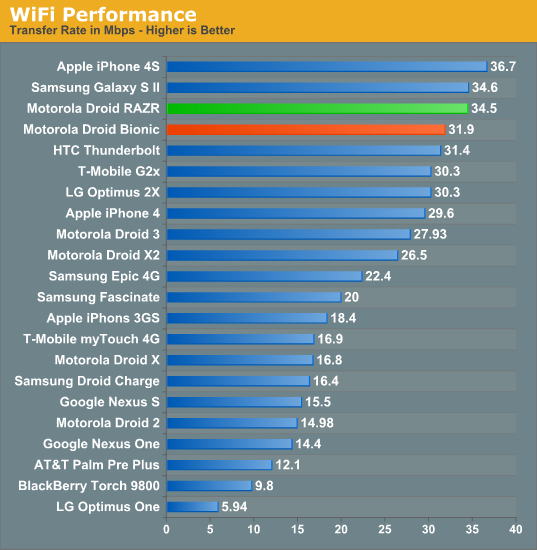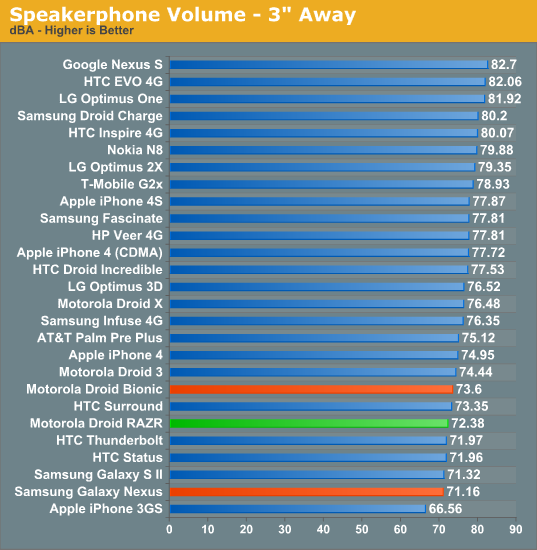Motorola Droid RAZR Review - A Better Clad Bionic
by Brian Klug on December 16, 2011 2:01 AM EST- Posted in
- Smartphones
- Droid
- LTE
- 4G
- Motorola
- Android
- Mobile
- Droid RAZR
- motorola droid RAZR
WiFi, GPS, Audio and Speakerphone
The RAZR uses a TI Wilink 7 series WL1285 combo chip for Bluetooth and WiFi, which is the same situation as the Bionic, unsurprisingly. WiFi is limited to 2.4 GHz and single spatial stream 802.11n, and I saw the RAZR negotiate a 65 Mbps (long guard interval) physical rate with my 20 MHz 802.11n wireless network. I found that range on the RAZR is totally on par with other smartphones I’ve used. Though the visualization at the top seems to be rather conservative with showing bars, if you go view the actual RSSI for WiFi (inside ##4636## and Wireless Information) you’ll see things are just fine. Bluetooth is 4.0 LE + EDR which is the latest bleeding edge.

Throughput on WiFi is pretty decent and just a tad faster than the Bionic. It’s possible the subtle software differences between the two account for this difference in throughput.
WiFi Hotspot
I had some issues with the RAZR’s WiFi hotspot that I didn’t encounter with the Bionic. Specifically, when using the hotspot with WPA2 enabled, clients would only be able to attach occasionally for a short period, or not at all. This initially posed lots of frustration when trying to do our WiFi hotspot battery life test, however disabling encryption entirely and running a public AP resulted in no instability.
You still can attach a maximum of 5 clients if you pay the extra fare to Verizon to enable tethering (which the device does check to see is provisioned), and on the whole this works well, just only with security set to open in my experience.
GPS
To the best of my knowledge, the RAZR is using the GPS system onboard MDM6600 and not from the TI Wilink 7 series combo chip. It’s a bit hard to nail down for sure, but I was able to confirm on the Bionic and it seems reasonable that the same applies here.
Like we’re used to seeing from that system, GPS locks are super fast even indoors and don’t pause or stutter at all. I didn’t have any issues with GPS and used the RAZR a few times with Google navigation without any hitch.
Audio + Speakerphone
First up in the audio department is speakerphone loudness, which we’ve been measuring for a while now using a USB sound level data logger while placing a test call to the local ASOS. The RAZR is on the quiet side which isn’t incredibly surprising considering the placement and constraints on the size of its acoustic chamber.

The other part of audio is of course call quality, and the RAZR isn’t different at all subjectively from the other Motorola phones on Verizon I’ve reviewed recently. As a reminder all calls go over 1x voice, and by default almost every device uses the EVRC coder, though you can change this to 13k in the programming menu and perceive a slight change in call quality. Noise cancellation features likewise remain the same, again courtesy of the three microphones onboard the RAZR.
The last important audio quality metric is what the device sounds like when playing back music. The Bionic used an ST-E 3.1 CPAC combo power management IC and audio codec, and the RAZR uses an ST-E 3.2 CPCAP. I’m embarrassed to admit it, but I only recently discovered how to change (read: disable) the DSP that Motorola has enabled on the RAZR by default (and ostensibly many other of their devices that have crossed my desk). Because I use Google Music, I rarely venture into the first party Music application, and it’s inside here that the settings lurk for DSP, which are by default enabled.
The background whine that I complained about on the Bionic is reduced but still faintly perceptible with sensitive IEMs on the RAZR. Though it is still present, it’s no longer as fatiguing and irritating as it was on the Bionic. I’m not sure whether that’s more a function of ST-E’s 3.2 (as opposed to 3.1) or something else, but it’s much better.
If you’re interested, I also ran a run of RMAA using an ASUS Xonar Xense sound card and line-in on the RAZR, Nexus S with VoodooSound, and a GSM Galaxy Nexus for comparison. The RAZR with all of the equalizer and DSP settings turned off actually isn’t bad at all, and though I’m not an expert at reading RMAA’s tea leaves, it has good noise figures and frequency response, and though noise takes off at the lower frequencies as our own Chris H. pointed out this less than ideal behavior is only 7% of the spectrum.










76 Comments
View All Comments
sjprg2 - Monday, December 19, 2011 - link
BIG DEFICIENCY!!!The hands free bluetooth implementation is broken in the sense that it no longer announces whom the caller is. Every previous Motorola phone I have owned tells me who is calling.
Califorina has a handsfree cellphone law and it is very important that I know whom is calling before I answer in the car in freeway traffic. Business calls I may answer, personal calls can wait. This is a deal breaker! I'm stuck with this until they fix it but I am damed unhappy and if I had known I would not have purchased it. It is more of a toy then a useful phone, granted an atractive toy, but still a toy.
Does the Apple 4S bluetooth work?
sjprg
QQBoss - Tuesday, December 20, 2011 - link
I am living in China, and trying to purchase the 4G version of the Razr (unlocked, of course, or at least unlockable). The Chinese version is the XT912, and does not have 4G support (which makes sense, since China doesn't have a 4G network yet). I travel back to the USA periodically, so having 4G for when I am not in China is worth something to me. I have heard said that the non-USA versions of the Razr might have 4G locked off, so this worries me.I found an XT910 brought in by grey market here, but I noticed some things that seem off: 1) it only says Razr, not Droid Razr (so it is probably not the USA version of the phone, I think it was from Singapore) 2) No documentation indicates whether or not it supports 4G, and it doesn't ship with anything other than a basic charger (if there was an external 16 GB microSDHC, it was removed by the seller) 3) Under the different networks supported in the menus, I find one that says "other" with no explanation (could be 4G, but since China networks don't recognize it, it doesn't register?).
I don't care about the lack of the SDHC, I will get a 32 GB class 10 anyway, and chargers are cheap here, but spending roughly US$500 and not getting the actual phone I want seems like a bad option- there are no refunds for grey market. Unfortunately, I didn't write down the baseband ID number. Anyone have a guess?
introiboad - Tuesday, December 20, 2011 - link
Worth mentioning that the RAZR is the second (after the 4S) phone to include support for BLE. Instead of waiting for Google to get their act together and add a standard API to Android, Moto has bundled its own stack (provided by a third party) along with a set of APIs.This makes for very interesting applications such as key fobs, hear rate monitors and many others.
dj christian - Thursday, December 22, 2011 - link
What is BLE?doobydoo - Tuesday, January 17, 2012 - link
It says what it means in his post title, 'Bluetooth Low Energy' - basically it's Bluetooth 4.0.http://www.bluetooth.com/Pages/Bluetooth-Smart-Dev...
verasingh - Wednesday, August 28, 2019 - link
I have finally found correct way to resolve fix canon printer offline error windows 10 .if you have needed this service then you come our websites .<a href="https://www.canonprintersupport247.com/blog/how-to... printer offline</a>